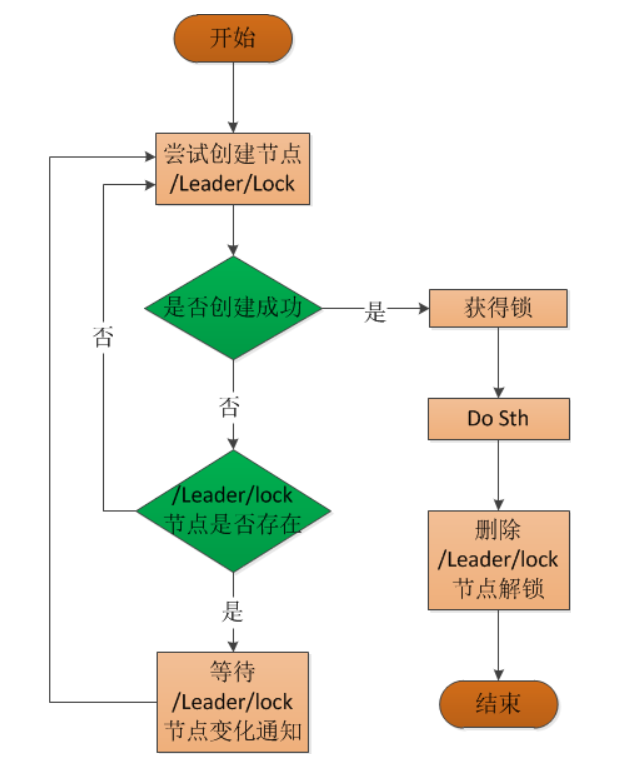Zookeeper(四):利用ZK节点特性做共享锁功能
-
N台服务器对同一个文件进行修改,这个时候要给这个文件加锁。
-
-
原理流程

-
Lock
package com.rzp.service; import java.io.Closeable; import java.io.IOException; import java.util.concurrent.TimeUnit; import java.util.concurrent.locks.Condition; import java.util.concurrent.locks.Lock; import org.apache.log4j.Logger; import org.apache.zookeeper.CreateMode; import org.apache.zookeeper.KeeperException; import org.apache.zookeeper.WatchedEvent; import org.apache.zookeeper.Watcher; import org.apache.zookeeper.Watcher.Event.EventType; import org.apache.zookeeper.ZooDefs.Ids; import org.apache.zookeeper.ZooKeeper; import org.apache.zookeeper.data.Stat; /** * 实现自定义的分布式锁机制 * * @author gerry * */ public class DistributedLock implements Lock, Closeable, Watcher { public static final Logger logger = Logger.getLogger(DistributedLock.class); private ZooKeeper client = null; // zk的客户端 private String rootPath = "/distributed_lock"; // 锁机制的根节点 private String nodePath = null; // 节点路径 private int sleepTime = 1000; private String currentIp = null; /** * 传入一个lock节点名称 * * @param lockNodeName * @throws InterruptedException * @throws KeeperException * @throws IOException */ public DistributedLock(String lockNodeName) throws IOException, KeeperException, InterruptedException { this("192.168.98.129:2181", lockNodeName); } /** * 根据传入的zk连接字符串和lock的节点名称进行初始化操作 * * @param url * @param lockNodeName * @throws InterruptedException * @throws KeeperException * @throws IOException */ public DistributedLock(String url, String lockNodeName) throws IOException, KeeperException, InterruptedException { this(url, 48000, new Watcher() { @Override public void process(WatchedEvent event) { // nothings } }, lockNodeName); } /** * 根据传入的参数构建zk客户端和lock实例 * * @param url * @param sessiontTimeOut * @param watcher * @param lockNodeName * 要求是一个只包含数字字母和下划线的单词 * @throws IOException * @throws InterruptedException * @throws KeeperException */ public DistributedLock(String url, int sessiontTimeOut, Watcher watcher, String lockNodeName) throws IOException, KeeperException, InterruptedException { // TODO: 对lockNodeName进行验证 this.nodePath = this.rootPath + "/" + lockNodeName; this.client = new ZooKeeper(url, sessiontTimeOut, watcher); try { this.currentIp = java.net.InetAddress.getLocalHost().getHostName(); } catch (Exception e) { this.currentIp = "unkown"; } // 在jvm中添加一个client关闭的钩子 Runtime.getRuntime().addShutdownHook(new Thread(new Runnable() { @Override public void run() { try { DistributedLock.this.close(); } catch (IOException e) { // nothings } } })); // 进行根节点是否存在的判断操作 Stat stat = this.client.exists(this.rootPath, false); if (stat == null) { // 表示根节点不存在啊,创建 try { this.client.create(this.rootPath, null, Ids.OPEN_ACL_UNSAFE, CreateMode.PERSISTENT); } catch (Exception e) { // 1. 其他的进程创建了;2. 确实是创建失败 stat = this.client.exists(this.rootPath, false); if (stat == null) { throw new IOException(e); } } } } @Override public void lock() { boolean result = false; while (!result) { try { result = this.internalLock(); if (result) { break; // 结束循环 } } catch (Exception e) { logger.warn("获取锁发生异常", e); } try { Thread.sleep(this.sleepTime); } catch (InterruptedException e) { } } } @Override public void lockInterruptibly() throws InterruptedException { boolean result = false; while (!result) { result = this.internalLock(); if (result) { break; // 结束循环 } Thread.sleep(this.sleepTime); // 休眠1秒 } } @Override public boolean tryLock() { boolean result = false; try { result = this.internalLock(); } catch (Exception e) { logger.warn("获取锁发生异常", e); } return result; } @Override public boolean tryLock(long time, TimeUnit unit) throws InterruptedException { return this.internalLock(time, unit); } /** * 内部的获取锁方法,返回true,表示获取锁成功 * * @return * @throws InterruptedException */ private boolean internalLock() throws InterruptedException { while (true) { try { Stat stat = this.client.exists(this.nodePath, false); // 判断是否存在 if (stat == null) { // 表示不存在 // 创建一个节点,设置为临时节点即可 try { this.client.create(this.nodePath, this.currentIp.getBytes(), Ids.OPEN_ACL_UNSAFE, CreateMode.EPHEMERAL); return true; // 获得锁 } catch (KeeperException e) { // 创建失败, 添加监视机制 this.client.exists(this.nodePath, this); } } else { // 存在,所有添加监视机制 this.client.exists(this.nodePath, this); } // 失败 synchronized (this) { this.wait(); // 等待继续创建 } } catch (KeeperException e) { Thread.sleep(this.sleepTime); } } } /** * 内部的获取锁方法,返回true,表示获取锁成功 * * @return * @throws InterruptedException */ private boolean internalLock(long time, TimeUnit unit) throws InterruptedException { if (unit != TimeUnit.MILLISECONDS) { throw new IllegalArgumentException("时间单位必须为毫秒"); } long startTime = System.currentTimeMillis(); long millisTime = time; while (true) { try { Stat stat = this.client.exists(this.nodePath, false); // 判断是否存在 if (stat == null) { // 表示不存在 // 创建一个节点,设置为临时节点即可 try { this.client.create(this.nodePath, this.currentIp.getBytes(), Ids.OPEN_ACL_UNSAFE, CreateMode.EPHEMERAL); return true; // 获得锁 } catch (KeeperException e) { // 创建失败, 添加监视机制 this.client.exists(this.nodePath, this); } } else { // 节点存在, 添加监视机制 this.client.exists(this.nodePath, this); } // 失败 synchronized (this) { this.wait(millisTime); } long endTime = System.currentTimeMillis(); if (endTime - startTime > millisTime) { // 如果过期时间超过time return false; } } catch (KeeperException e) { Thread.sleep(this.sleepTime); } } } @Override public void unlock() { // 解锁, 直接删除节点 try { if (this.client.exists(this.nodePath, false) != null) { this.client.delete(this.nodePath, -1); } } catch (InterruptedException | KeeperException e) { throw new RuntimeException("解锁失败", e); } } @Override public Condition newCondition() { return null; } @Override public void close() throws IOException { if (this.client != null) { try { this.client.close(); } catch (InterruptedException e) { throw new IOException(e); } finally { this.client = null; } } } @Override public void process(WatchedEvent event) { if (EventType.NodeDeleted.equals(event.getType()) && this.nodePath.equals(event.getPath())) { // 表示是节点删除操作,而且是锁节点 synchronized (this) { this.notifyAll(); // 通知全部 } } } }
-
测试
package com.rzp.service; import java.util.Random; import java.util.concurrent.CountDownLatch; import java.util.concurrent.TimeUnit; /** * 测试我们的分布式锁能否使用 * * @author gerry * */ public class DistributedLockDemo { public static void main(String[] args) throws Exception { test3(); } static void test3() throws Exception { final DistributedLock lock = new DistributedLock( "lock"); int n = 10; final CountDownLatch latch = new CountDownLatch(1); final CountDownLatch latch2 = new CountDownLatch(n); final Random random = new Random(System.currentTimeMillis()); for (int i = 0; i < n; i++) { new Thread(new Runnable() { @Override public void run() { int millis = random.nextInt(5000) + 1000; try { latch.await();// 等待 System.out.println(Thread.currentThread().getName() + "线程休眠:" + millis); Thread.sleep(millis); } catch (InterruptedException e) { } // 开始执行 System.out.println(Thread.currentThread().getName() + "休眠结束,开始获取锁"); lock.lock(); try { System.out.println(Thread.currentThread().getName() + "获得锁 " + System.currentTimeMillis()); try { Thread.sleep(millis); } catch (InterruptedException e) { e.printStackTrace(); } } finally { System.out.println(Thread.currentThread().getName() + "准备释放锁"); lock.unlock(); latch2.countDown(); } } }, "2thread(" + i + ")").start(); } latch.countDown(); // 启动 latch2.await(); // 等待执行完成 System.out.println("所有线程执行完"); lock.close(); } }
